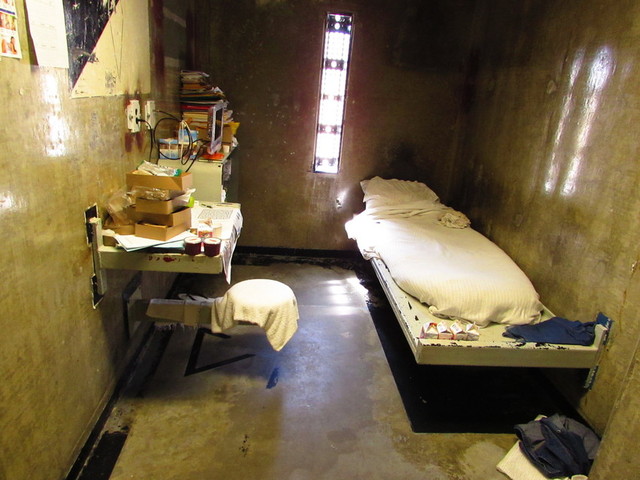The issue was brought to light last year through graphic videos shown in court in a lawsuit that was begun in 1990, a lawsuit brought by inmates to improve psychiatric care.
Prisons record some use of force incidents, according to department policy.
[Related: A Day in California's Psychiatric Prison Units]
One video showed custody staff at Corcoran State Prison struggling to remove an inmate who was hallucinating and refusing to leave his cell in order to receive medication.
The inmate had taken off his clothes and smeared feces on himself. When he refused to submit to handcuffs, guards in gas masks sprayed a potent pepper spray into the cell, causing the inmate to gasp for air.
The video showed that as the inmate screamed for help, an officer ordered him to “turn around and cuff up.”
The inmate screamed back, “Open the door!”
When the inmate still wouldn't “cuff up” the officers sprayed him again, repeatedly.
Later, the video showed guards rushing in and wrestling the inmate to the floor and into restraints.
“He has described this as making him feel like less than an animal,” said Lori Rifkin, an attorney for inmate Jermaine Padilla, who is suing the Department of Corrections.
Rifkin says two years on, her client still has flashbacks and nightmares from the process prison officials refer to as a “cell extraction.”
Padilla believes the experience at Corcoran worsened his schizophrenia and bi-polar disorder and has permanently damaged him.
“It changed something in him,” Rifkin says. “He’d never been treated that badly, and it broke something in him.”
The Padilla video, and five others shown last fall, were the latest revelation in a long history of problems with mental health care in California prisons that have prompted federal court intervention.
U.S. District Judge Lawrence Karlton called the video evidence “horrific.” In April, he ordered new restrictions on the use of force. He banned the use of pepper spray on mentally ill inmates in cells and psychiatric holding facilities with few exceptions. He instructed prison officials whenever possible to defer to clinicians about whether to use force.
On August 1st, the judge signed off on the Department of Corrections’ reform plan.
Among the changes: prison staff will be trained to collaborate and to exhaust every reasonable alternative to force.
Craig Brown, a lobbyist for the California Correctional Peace Officers Association agrees with this approach. “The critical element is to appropriately train our members to recognize what they’re dealing with,” Brown said.
Brown says the union has been pushing for better training for years. He says additional training will help them interact with the growing percentage of mentally ill inmates.
“They’ll recognize what’s going on," Brown said. "They’ll know when they need to talk to a mental health professional. They know when they don’t."
The state department of corrections declined to be interviewed for this story. They referred KQED to their plan filed with the court.
Under that plan a mental health clinician must be called in to evaluate an inmate’s mental status to determine whether they’re able to understand directions. This evaluation now must happen before officers can proceed with use of force. If a clinician decides force shouldn’t be used, correctional officers can no longer override that decision. Instead, the conflict will be referred to senior management to resolve.
Dr. Alan Abrams says the state’s plan reinforces the values and strategies he used when he was the chief psychiatrist at the California Medical Facility in Vacaville. Abrams, who left the post a couple years ago, says staff at most prisons already collaborate well.
Abrams believes the problem is that there have been a limited number of ways to handle violent inmates.
“One (inmate) is brutalizing another," he explained. "Yes, they’re labeled mentally ill, but you need to stop the violence very quickly. It’s not a discussion.”
In his 12 years working in prisons Abrams says he ordered force numerous times to keep inmates from killing each other or themselves.
“What do you do about the inmate who’s in their cell with a t-shirt, in a noose, saying they’re going to kill themselves unless you release them from prison?” says Abrams, “You’re not going to watch him hang himself. You’re not going to release him from prison, and so you say to your custody co-workers ‘You better get them down!’”
But Terry Kupers, a national expert on correctional mental health believes the pepper-spraying incidents indicate inadequate mental health care in the prisons. He says prisons can and should mitigate conditions that exacerbate mental illness.
“The pepper spray, the cell extractions, the beatings, the violence among prisoners--all those constitute reenactments of trauma in people who were previously traumatized and make them more emotionally disabled,” Kupers said.
California prison officials believe they will have fully implemented the reforms by the end of this year. But they’re still negotiating another critical change to how mentally ill inmates are managed.
Judge Karlton wants a proposal by next week that will restrict how often and for how long prisons can house inmates with mental disorders in segregation units -- where their illnesses can and do worsen.
